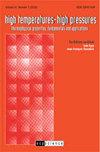FEM heat transfer modelling with tomography-based SiCf/SiC unit cell
IF 0.6
4区 工程技术
Q4 Engineering
引用次数: 0
Abstract
Modern industry has become increasingly reliant on composite materials for a variety of applications, and the nuclear industry is no exception to this. Among the materials being researched as Enhanced Accident Tolerant Fuels, ceramic matrix composites such as SiC-fiber-reinforced SiC (SiCf/SiC) figure as some prime candidates due to their excellent high temperature performances. SiCf/SiC so far shows adequate nuclear, mechanical and chemical properties; still, the thermal properties need further investigation. The thermal behavior of a material is an important factor for its performance as a nuclear fuel cladding, i.e. the first barrier encapsulating the fuel pellets. Many features determine the resulting properties of composite materials, such as matrix and fiber reinforcement properties and orientation, void fraction, and pore morphology. This study establishes a methodology to study the physical properties of composite materials and applies it to SiCf/SiC. A FEM model is used to characterize the thermal properties of a fundamental SiCf/SiC element, referred to as a �unit cell�, with the objective of accurately predicting the thermal properties of this complex class of materials where experimental data is often difficult to obtain. The unit cell is built based on data acquired with high-resolution tomographic microscopy performed at the TOMCAT beamline of the Swiss Light Source. By using phase-retrieval prior to tomographic reconstruction, the pores, fibers and matrix that compose the material can be distinguished in the data analysis. The separated information is processed to obtain geometrical information about the individual pores and fibers, which is then used to parametrize them as cylindrical objects. This allows constructing a FEM model of a cubic unit cell that is used to extract the effective thermal properties of SiCf/SiC. The analysis scheme includes steady-state and dynamic thermal transport simulations, which yield directional effective thermal conductivity and diffusivity values, respectively. Both modes of analysis show isotropic thermal conductivity values in the range of 71 W/m/K at room temperature, more than three times that of currently employed nuclear cladding materials. Combining these results with the data on the larger structural features of the material will lead to realistic results on the macroscopic thermal properties.基于层析成像的SiCf/SiC单元胞的有限元传热模拟
现代工业越来越依赖于复合材料的各种应用,核工业也不例外。陶瓷基复合材料如碳化硅纤维增强碳化硅(SiCf/SiC)具有优异的高温性能,是目前研究的增强型耐事故燃料的首选材料。迄今为止,SiCf/SiC表现出足够的核、机械和化学性能;尽管如此,其热性能仍需进一步研究。材料的热性能是决定其作为核燃料包壳(即封装燃料球团的第一道屏障)性能的一个重要因素。许多特征决定了复合材料的最终性能,如基体和纤维增强性能和取向、空隙率和孔隙形态。本研究建立了一种研究复合材料物理性能的方法,并将其应用于SiCf/SiC。有限元模型用于表征SiCf/SiC基本元素(称为“单元格”)的热性能,目的是准确预测这类复杂材料的热性能,而这些材料的实验数据通常难以获得。该单元是基于在瑞士光源的TOMCAT光束线上进行的高分辨率层析显微镜获得的数据构建的。通过在层析重建之前使用相位检索,可以在数据分析中区分组成材料的孔隙、纤维和基体。对分离的信息进行处理以获得有关单个孔隙和纤维的几何信息,然后使用这些信息将它们参数化为圆柱形物体。这允许构建立方单元胞的有限元模型,用于提取SiCf/SiC的有效热性能。分析方案包括稳态和动态热输运模拟,分别得到定向有效导热系数和扩散系数值。两种分析模式均显示室温下各向同性导热系数值在71 W/m/K范围内,是目前使用的核包层材料的三倍多。将这些结果与材料更大结构特征的数据相结合,将导致宏观热性能的现实结果。
本文章由计算机程序翻译,如有差异,请以英文原文为准。
求助全文
约1分钟内获得全文
求助全文
来源期刊

High Temperatures-high Pressures
THERMODYNAMICS-MECHANICS
CiteScore
1.00
自引率
9.10%
发文量
6
期刊介绍:
High Temperatures – High Pressures (HTHP) is an international journal publishing original peer-reviewed papers devoted to experimental and theoretical studies on thermophysical properties of matter, as well as experimental and modelling solutions for applications where control of thermophysical properties is critical, e.g. additive manufacturing. These studies deal with thermodynamic, thermal, and mechanical behaviour of materials, including transport and radiative properties. The journal provides a platform for disseminating knowledge of thermophysical properties, their measurement, their applications, equipment and techniques. HTHP covers the thermophysical properties of gases, liquids, and solids at all temperatures and under all physical conditions, with special emphasis on matter and applications under extreme conditions, e.g. high temperatures and high pressures. Additionally, HTHP publishes authoritative reviews of advances in thermophysics research, critical compilations of existing data, new technology, and industrial applications, plus book reviews.
 求助内容:
求助内容: 应助结果提醒方式:
应助结果提醒方式:


